How to Build a Workbench – Leg Frame Tenons (part6)
NOTE:Just so you know, this is an older workbench series. Paul has a newer Workbench series. If you are interested in the updated version of Paul’s workbench please click the button down below. This page links to a cutting list, tools list, FAQS and much more.
Creating tenons that fit mortise holes
In situations like this it’s typical to place the tenons and the mortises in the centre of leg and rail. Other projects work on one-third and one-quarter principles surrounding issues and features such as moulds, glass thicknesses, strength and much more. The legs being so big could have any sized tenon from ½” to 1”, which would have been fine. A ½” tenon is large enough and takes less energy without compromising strength. You might want to consider larger tenons, but this will all depend on the stock sizes you have decided on.
My tenons are ½” in 1 ¾” thick material. It makes little difference in terms of effort as the cheeks are either sawn or split and the two methods I chose in this case, there are others, are not affected by thickness in any way.
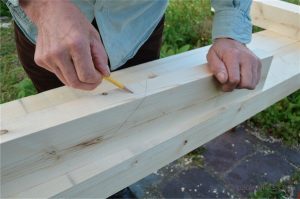
Because the ends of the top rails lie flush with the outside faces of the legs, and the bottom rail protrudes by 5/8” at each end, the bottom rail is 1 ¼” longer than the top rail.
I therefore centre my top rails equidistant to the ends of the bottom rails so as to establish my shoulder lines to all four crossrail pieces at the same time.
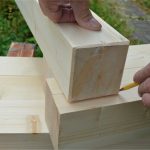
I have ganged up all four of my cross rails, which is common practice in joinery. This then guarantees all the shoulder lines are identically distanced.By laying the leg on the rails and flushing the leg to the end of the shorter top rail, I can directly mark the distance for the shoulders from the thickness of the leg. I am using a pencil for my initial mark. Subsequent shoulders will be cut using the knife.
I am using a Stanley pocket knife to establish the exact shoulder lines. for my cut with the saw.This gives excellent shoulder cuts dead square all around.
I square this knifewall around each end of the rails and then run my mortise gauge to establish the cheeks of the tenon in each edge and the end of the rails. Set the points of the pins to each side of the 1/2″ chisel you will use to chop the mortise. I should emphasize the ‘points’ and not the base of the pins as this will make the mortise wider than the chisel. At this stage all of the tenons are the same and so they can all be marked out in the same way. The only difference will be the length of the tenons.
With the tenons marked out I further define the shoulderlines by horizontal cuts into the knifewall.
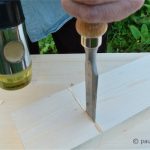
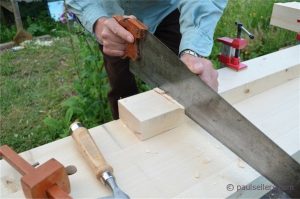
With the shoulders now cut I cut down the cheeks of the tenon taking care to cut on the waste side of the lines. I cut slightly proud of the lines so that I can trim-fit the tenons to the actual mortise and so ensure a tailored fit to each mortise hole. To do this I suggest you might use the #71 router shown here.
In my case I gave the final address with my poor man’s router because the extended length gave me the accuracy I wanted. This really works to finesse the tenons.


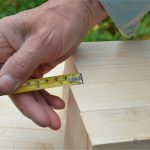
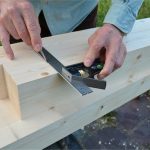
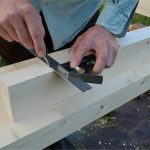
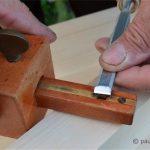
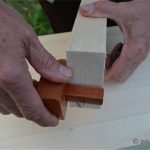
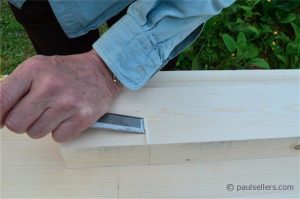
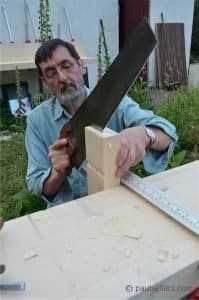
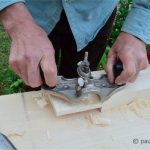
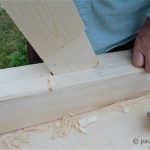
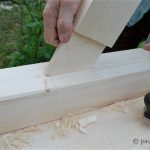
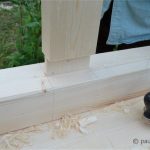
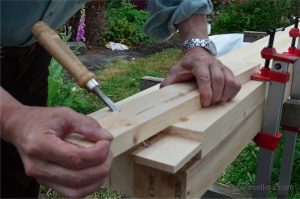

Paul,
Did you alreay mention the length of the rails? Is the overall bench depth approximately approximately 2′?
Brandon Avakian
In my boo we make a smaller version of this bench that works really well. The bench I am currently working on is a reconstruction of a bench I have seen throughout Britain and was made for over three centuries. It was generally 3-4′ deep, 33-40″ tall with most falling between 36-38″, and 8-10′ long. The one in my book was to create a doable bench inexpensively yet one that works well. I am fortunate in that I have my original at 3′ x8′ double sided workbench like the one I am currently making, but I also work daily from the small version as 2’x5′ and so do my students who love them.
I am posting drawings from my sketchbook today and there will also be cutting lists and finished sizes as suggestions. I don’t want to make things so rigid and legal because someone may have 3×2 available for free and feel like they can’t use them because I say 4×2. You can use almost anything.
I see. Thank you for the additional information. I have seen some photographs on the web of your bench in your book. My only concern was not to deviate from your plan and possibly compromise the integrity and rigidity of the bench. Thank you again.
Brandon Avakian
I actually travel the US with the small bench in my book, so that I don’t have a heavy load to lug around. This bench really works well for lighter frame work and for all joinery of any kind.
With the bench we are building two people can work comfortably. Because of the schools I have started for training others through the years I have personally built dozens of work benches using this basic design. Every one of them is still in use as far as I know.
Hi Paul,
Having cut the tenons on the first bottom rail, when I dry fit it into the leg mortices I noticed that the legs are no longer in line when standing up. I stupidly didn’t check my rail for twist before I cut the tenons and I suspect therein lies the explanation, but can you think of any other reason why this might have happened (I appreciate that you have very limited information to go on!)? Both tenons were cut dead on centre, but when routing them with my poor man’s router, I noticed that there was a gap on one side of the tenon between the chisel blade and the tenon, which wasn’t present on the other side of the tenon.
I’m making a bench out of conventional 2×4’s to set my old lathe on. Already have built my workbench but using this opportunity to practice cutting out some mortise and tenons.
I stumbled across something that I thought might be a good idea and thought I’d pass it along since I haven’t seen Paul do this but ever so simple!
After cutting the tenon, I would lie my bench plane against the shoulder to verify it fit nice and tightly against the edge. Make small cutting adjustments until it does.
Just seemed easier, for me anyway, to do this now vs when I’m trying to fit the piece into the mortise, at which point I only need to concentrate on fine adjustments to the tenon thickness. I already have fined tuned the shoulder using the bench plane!
Like I said, seemed like a good idea so I was passing it along. Hopefully will help someone else.